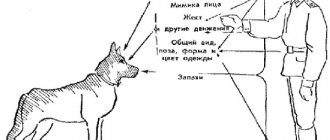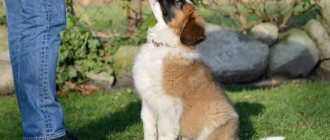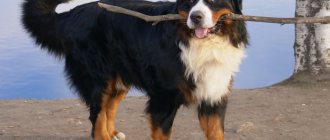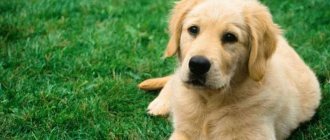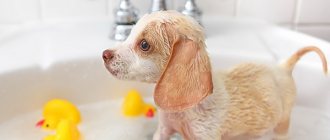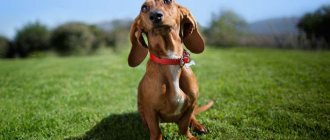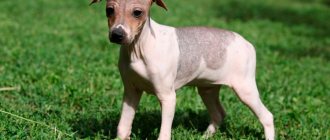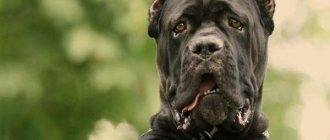Owners sometimes feel like their pets sleep soundly day and night. However, the average dog sleeps at night and naps after eating or walking intensively. Of course, the duration and frequency of a dog’s sleep depends on many factors, such as character, age, and health. But there are still average data on how much dogs sleep per day and at what time.
As it turns out, the sleep of dogs and people is identical in structure, only the periods last differently. There are the following types of sleep
- Napping - the dog is relaxed, but conscious.
- Shallow sleep - the animal is completely relaxed, but hears surrounding sounds.
- Deep - only at this stage does the pet’s muscles rest, he can move his lips or jerk his limbs.
- Fast - the animal is motionless, relaxed, only the eyes move. After this stage, the pet wakes up or enters a phase of shallow sleep.
First days of life
In the first two weeks of life, puppies eat only their mother's milk. During this period, it is necessary to provide nutritional and calorie content to the feeding dog’s diet. If she does not have enough milk, the cubs can be given to another lactating bitch. The fact that it is missing is indicated by the restlessness of the litter: the puppies sleep little and poorly, squeak, crawl and whine. Well-fed puppies fall asleep immediately after feeding and sleep long and soundly. A clear indicator that there is enough milk is their constant weight gain. Cubs must receive colostrum after birth, otherwise there is a high risk of death of the litter.
In the absence of a mother, puppies are fed using a dog milk replacer purchased at a pet store or veterinary clinic. The procedure is carried out using a bottle and nipple.
If the mother is kept with the puppies, they should always be able to nurse whenever they want to eat. If for some reason the bitch is separated from her litter, then they should be fed at least 12 times a day.
Why does your dog sleep so much?
However, it is important to remember that you are the center of the universe for your dog. Jessica Potosky, DVM, says dogs tend to spend most of the day sleeping unless you keep them occupied with other things. She believes that if healthy dogs sleep a lot, it means they simply have nothing to do. Most dogs would love to play or just spend time with their owners if given the opportunity.
Your dog probably knows how to differentiate when you are busy and when you can give him attention. If you are playing or otherwise interacting with him, he is alert and ready for it, but if you are busy, the dog will most likely decide to rest or take a nap.
So if you're concerned that she's sleeping too much, try engaging her in some playtime. Dogs need play, socialization, and activity just as much as we do to enjoy life. Remember that to your dog you are the whole world!
Feeding puppies from 1 month
As a rule, experienced breeders sell puppies after 1.5 months of their life. In some nurseries you can buy a puppy no earlier than 3-4 months, after the end of the vaccination quarantine. However, in some cases, for example, when a pet is sold without documents, the owners begin to sell the litter as early as 1 month.
Feeding a puppy at this age should not be difficult for the owner. Most often, breeders begin feeding babies at three weeks so that they can eat from a bowl themselves. But when you bring your pet into the house, you need to prepare the necessary minimum of food for several days.
This list includes:
- buckwheat, oatmeal, rice;
- chicken, beef;
- offal;
- carrots, pumpkin;
- kefir, milk, cottage cheese and semolina.
How to prepare for the process of training a puppy to use the toilet outside?
- Be patient
The puppy is not always picky about your mood, and remembering a place for him to relieve himself is not so easy. Success can only be achieved if the training process takes place regularly, without aggression from the owner.
- Prepare a place for a toilet in the house
Why prepare a toilet area for a puppy in the house if we want him to relieve himself outside?
The puppy does not know how to endure and relieves itself much more often than an adult dog, therefore, when you are not at home or at night, the puppy will use a dedicated tray. It is better to cover the place for relieving yourself with disposable diapers or newspapers.
- Free up time for toilet training your puppy
For the first 1-2 weeks after you decide to train your puppy to toilet outside, it is recommended to walk him as often as possible and praise him for doing this outside.
- Remove carpets from the floor
During the period of toilet training a puppy, it is better to remove all carpets, since the puppy may relieve itself on it, because it is more pleasant to do this on a soft surface than on the street or on a newspaper. Do not give your dog such temptation; remove the carpet from the floor for a certain time.
What should the food be like?
How to serve food for feeding puppies from 1 month? You should know that all foods in the diet should be highly chopped. But you shouldn’t grind food in a blender. The puppy must learn to chew its food.
Initially, meat products are boiled, but after a week the meat can already be served raw in two out of three feedings. The food should not be hot or cold; the best option is to have the food at room temperature.
It is important to know the feeding portions for puppies. The amount of food per day for a month-old pet is calculated based on the breed; large dogs require more food.
Vaccination
To prevent dangerous infectious diseases of viral origin, children are vaccinated on time. At the same time, not only the schedule, but also the rules of vaccination are observed:
- The first vaccination is given at 2-2.5 months, after 3 weeks repeated immunization is carried out; after this, the first walk with the puppy is possible;
- Only healthy dogs are vaccinated;
- deworming is prescribed on the 14th day after immunization;
- A newly vaccinated baby should not be exposed to a cold, be stressed or washed (it is especially important to follow this rule if the vaccination is carried out for the first time);
- maintain a 3-week interval between vaccinations;
- The duration of mandatory quarantine after vaccination is 2 weeks.
The complex of activities listed may seem burdensome. However, this feeling quickly passes. Responsibilities are carried out with enthusiasm when complete understanding and warm affection are established between the owner and his velvet treasure.
Feeding at 1.5-2 months
Most often, it is at this age that the cub is taken away from its mother and given away or sold. Bowls and toys are already ready for him in his new home. A warm and soft place awaits the baby. And at this moment, the future owner has a question about how to ensure proper feeding of a 2-month-old puppy.
His diet should resemble that of the breeder: meat, cereals, milk and soups. A couple of times a week you can offer boiled and boned lean fish, washed and chopped vegetables (zucchini, cucumbers, carrots, tomatoes, pumpkin). A puppy trained from early childhood will eat them with pleasure when he grows up.
Preparations for the meeting
With the addition of a four-legged creature to the family, changes in the interior of the apartment are inevitable. When a little dog arrives in the house, you should prepare everything you will need for the first time:
- a set of bowls for food and drink;
- litter tray;
- grooming tools;
- outdoor accessories (leash, collar, overalls for the cold season);
- “chewing” elastic toys (with them the puppy will be able to “scratch” the gums, from which the first milk teeth will erupt);
- repellent spray, the smell of which will correct the behavior of the ward, who loves to gnaw and scratch everything.
You should build a cozy dog house for the new guest. A soft rug or mattress will cope with this role. The lounger should be in a warm and quiet place, away from medications, electrical wiring, piercing and cutting objects.
From the breeder you need to take not only documents confirming the dog’s pedigree, but also detailed information about the health and features of caring for the newborn. The following information will be helpful:
- what ailments afflicted the cub’s parents;
- how the birth proceeded - with or without complications;
- whether the breeder gave the puppy the first complementary foods and where he started;
- what kind of litter the dog is accustomed to;
- whether immunization was carried out, what vaccinations were given and when;
- when was the kitten dewormed for the first time, how much time passed after the last deworming.
It would be a good idea to get the veterinarian’s phone number in advance.
Feeding a 3-5 month old puppy
What to feed a puppy at three months and older? At this age, the diet remains the same. It is also based on dairy products and meat, as the main sources of animal protein necessary for a young body. Protein can also be obtained from fish, but it is not recommended to give it too often. Fruits, vegetables and grains are sources of vitamins and carbohydrates.
Additionally, pets can be given food supplements (meat and bone meal, blood meal, fish meal) and fats (flaxseed, sunflower and pumpkin oil, fish oil). During this same period, the puppy should become familiar with boiled lungs and liver, as well as tripe and brain bones (to strengthen teeth). In addition, chicken and beef are introduced.
How often should you feed
In order for your pet to receive the amount of nutrients it needs per day, you should create an optimal feeding schedule for the puppy. How often to feed depends on the age of the animal. The younger he is, the more often he should eat in small portions. With age, the number of meals is reduced, and the volume of food is increased. All this helps to divide the daily diet into optimal parts.
Feeding a puppy from one to two months should occur every three hours. At the age of three months the dog eats 4-5 times a day, at six months - 3-4 times a day, and after the first year the pet is transferred to two meals a day.
The reason for frequent feeding of a puppy at one month of age is the small stomach, which is not able to accommodate the required amount of food, but at the same time the growing body requires a large number of calories.
Caring for puppies after birth or how to care for very small puppies?
First of all, you need to allocate a special place where the mother and her babies will be. You should equip it with everything necessary, make soft warm bedding, prepare an electric heating pad, it may be needed to warm the puppies, an electric scale for weighing the puppies, as well as a dog milk replacer in case the milk is not enough or the puppies are so weak that They will not be able to suckle milk on their own and will have to be given a milk replacer from a syringe.
Be prepared that in the first days of life of newborn puppies you will need to constantly be close to the dog and its puppies, this is especially true for a young dog that is bringing a litter for the first time. To do this, take a vacation and ask for help and share the schedule of care and control of the puppies and their mother with someone from the household.
If the dog is experienced, then caring for newborn puppies will not require much effort and attention from you. Dogs that are not mothers for the first time are distinguished by a very attentive and caring attitude towards puppies; they lick them especially carefully and regularly, which is very important for the life of newborn puppies. The fact is that licking stimulates blood circulation, digestion and bowel movements, as well as breathing of the newborn puppy. Newborn puppies cannot defecate on their own; it is the licking of the mother dog that stimulates this process. In the first days of the puppies' life, they lie clean and dry precisely thanks to such careful care on the part of their mother. If the dog is inexperienced or is in a weakened state after a cesarean section and cannot lick the puppies often, then you will have to periodically wipe the puppies’ bellies with a damp cloth and thus stimulate their vital processes.
From the first days of life, blind and deaf puppies are able to suck milk, making pushing movements with their front and rear paws; these actions create a massage of the nipples and stimulate milk production. It is very important that puppies first feed is colostrum. This is the first portion of milk that a dog produces during the first 3-5 days. The composition of colostrum has unique qualities; this milk contains nutrients and immunoglobulins that protect the weak organisms of puppies from various infections.
The sucking reflex is fixed from birth; puppies do not need to be taught this. However, there are situations when puppies are so weak that they cannot suck on their own or stay on the nipple. Then you need to help, hold the puppy, open his mouth and put the nipple in his mouth, first you need to massage the dog’s mammary glands so that colostrum is released from the nipple. The smell of colostrum will trigger the puppy's sucking reflex. If the puppies are very weak and are not able to suckle on their own, then they will have to be syringe-fed every 2 hours with a dog milk replacer. The first volumes of syringe feeding are 0.5-1 ml of milk; upon reaching a two-week period, the puppy can consume 5-10 ml of milk or milk replacer.
It is very important to monitor the weight of babies. Starting from the second day of life, puppies must be weighed daily and must gain weight daily. If this does not happen, it means the puppies are not getting enough nutrition, the mother does not have enough milk and you need to additionally feed them with milk or a milk substitute from a syringe.
Keep an eye on your dog's mammary glands; if there is an excess amount of milk, she may develop mastitis, which can be identified by swollen, hard and painful glands, they are hot and have a lumpy surface. At the first signs of mastitis, it is necessary to lubricate these glands affected by mastitis with camphor oil and perform a gentle massage to get rid of congestion in the mammary gland. If this doesn't help, be sure to contact your veterinarian!
Separate care should be taken to maintain warmth in the area where the puppies are located. Newborn puppies cannot control their body temperature and are susceptible to hypothermia. Puppies are warmed by their mother with her body, and puppies also warm each other by being in close contact. During the period when the mother is absent, she is on a walk or has gone to feed, the puppies need to be provided with additional heating, for this you need to use an electric heating pad.
Caring for newborn puppies requires constant monitoring. On days 7-10, you need to start trimming the puppies’ nails, just a little bit, just sharp hooks. Nails need to be trimmed once a week. This must be done so that the puppies do not injure the delicate skin of the mammary glands of the mother dog with their claws.
You also need to be especially careful to ensure that there is no inflammation of the navel stump in puppies. To do this, you need to lubricate your navel with brilliant green twice a day, morning and evening.
As puppies grow, they become more active; if at first they only sleep and eat, then from the third week of life, puppies begin to actively walk, defecate independently, play and fight with their brothers and sisters.
At the fourth week, the puppies have their first teeth, which means it’s time for complementary feeding. Gradually, the share of mother's milk in the puppies' diet will decrease; milk will be replaced by other foods.
The transition from milk to other products must be done gradually, and the condition of the puppies must be monitored. If the puppies are still weak, do not rush to switch them to another food. A gradual change in diet should take place in stages, first add one complementary food a day so that the puppy gets used to it, look at his reaction, then twice a day, then three, four, five, six until the mother’s milk is completely replaced.
Basic Rules
Regardless of your pet’s nutrition plan and feeding schedule, you should follow some rules:
- The feeding portion of any puppy should contain the amount of food according to the size of the baby.
- The portion increases according to age.
- The menu must include fermented milk and vegetable dishes.
- It is not recommended to feed babies dry food until they are three months old. If you need dry food, you should buy food specifically for dogs from one month old.
- A bowl of food should be given for no more than 15 minutes. This will help teach the animal discipline. There is no need to remove the cup of water.
- For the same reason, feeding should be done at a strictly defined time.
- When introducing a new product, it is given in small portions.
- After the baby has eaten, he needs to be given a little time to rest, after which he can begin active games.
- It is forbidden to alternate natural and dry food.
- The schedule should include fasting days a couple of times a month.
- Gradually, you can introduce various additives into the menu: chalk, fish oil.
A puppy's feeding regimen directly affects its health, no less than heredity. In this regard, it is important to select food in accordance with the individual and age characteristics of the pet.
Hygiene procedures
Caring for a newborn puppy involves observing sanitary requirements for the condition of the skin, claws, fur, eyes, and ears. The complex of hygiene measures includes:
- The washing up. A vaccinated puppy can be bathed on the first day of arrival at home. Once a month you should have a bath day using special puppy shampoo. After walks, just wipe your dirty paws and tummy with a damp cloth.
- Combing. Combs and brushes will help you carry out daily home grooming. During this manipulation, the fur will be freed from tangled tufts and dead undercoat. In order not to cause pain to your ward, you need to comb the fur, starting from the ends of the hairs, gradually moving to the roots.
- Trimming claws. To prevent the plates on the fingertips from delaminating or breaking off, they are shortened. This is first done at 6 days of age. For safe pruning, purchase a special tool from the pet store.
- Ear cleaning. Once every 7-10 days, it is necessary to remove the plaque that accumulates in the external auditory canal. This is done using cotton swabs dipped in a special lotion.
- Regular brushing of teeth will protect against serious diseases.
- Protection from parasites. Prevention of infestation of fleas, lice eaters, and ticks will be provided by a pharmaceutical protective agent in the form of a medicated collar, shampoo, drops or spray. The last two are applied to the withers. The validity period of protective drugs is 3-5 weeks. After ridding the kitten of fleas, be sure to carry out deworming, since bloodsuckers are carriers of worms.
Small breeds
Almost all small dogs are predisposed to heart and vascular diseases. Therefore, Yorkie, Toy Terrier, Chihuahua, Pekingese and other small breed puppies should be given a large amount of vitamin supplements from a young age. In addition, the menu of such a dog should be well balanced.
Puppies of small breeds must be provided with adequate complementary feeding with vitamin supplements containing increased amounts of fluoride and calcium. This is due to the structural features of the very vulnerable and long spine, which must have time to strengthen in a short period of time. You cannot compensate for poor food quality by increasing portions.
Puppy's first walk
Dental care
It is necessary to take your pet outside not only so that he learns not to pay attention to extraneous noise and run around in the fresh air, but also to teach him to relieve himself outside the house. For a walk you will need to purchase a collar, leash and muzzle. A small dog should get used to these accessories from the first walk.
The first walk is best done in your arms, because he may be afraid of the environment outside the home, and even in infancy he has not yet had all the vaccinations. Until he reaches six months of age, when going for his first walk, you need to hold the puppy in your arms, not allowing him to go down the stairs. For your first walk, it is better to choose a quiet place where there will be no people and no cars driving.
The first walk should be planned in a quiet place
The appearance of a four-legged friend in the house is a joyful event, but in order for the adaptation period to be smoother, the owner needs to surround him with care, as well as learn everything about puppies, and then he will be able to get a true friend.
Feeding medium breed puppies
These dogs require more essential nutrients and energy than a small breed puppy. But much less than for a large breed pet. The nutritional needs of such an animal can be covered by already balanced and ready-made feeds, which contain an average content of minerals, vitamins and nutrients.
Experienced breeders know that premium and holistic dry foods contain a balanced and optimal amount of fats, proteins, digestible fiber, minerals, vitamins and carbohydrates. This allows the owner of a medium breed puppy not to buy additional expensive food additives.
It is important to know that excess or, conversely, insufficient amounts of vitamins and minerals have a bad effect on the development and growth of the dog. A diet high in protein causes an imbalance in the amount of calcium and phosphorus in the pet’s body.
Large breeds
Features of the norms for feeding a puppy of a shepherd dog, labrador, husky, alabai, husky and other large breed dogs include an increased amount of protein compounds. In this case, lean meats should be combined with boiled or stewed vegetables. This food is best given to the puppy before bedtime and only in small portions.
With a properly formulated diet, a large breed pet should gain approximately 150 grams of weight every day. It is allowed to use both ready-made industrial feed and natural food. Ready-made food should be intended for puppies of large breed dogs. To understand how much food to give an animal at a time, you should divide the amount indicated on the package per day by the number of feedings.
You should know that large breeds are predisposed to joint diseases, so you should not overfeed the animal at an early age.
What not to feed
There are not so many foods that are prohibited for puppies, but they should definitely be taken into account when creating a menu for your dog. For one month, fresh cow's milk, liquid cereals made from milk, fresh wheat bread, pasta and potatoes are absolutely contraindicated for pets.
Puppies, regardless of breed and age, should not be fed raw chicken, raw river fish, chicken bones and sausage. In addition, the dog is prohibited from giving marinades, smoked meats, pickles and fried meat products. Fatty, sweet, rich and salty foods are also contraindicated.
Self-feeding
What can you feed newborn puppies? Bitch milk substitute mixture. This can be bought at pet stores. Several manufacturers produce formulas for puppies; Beaphar and Royal Canin are considered the best. What to feed your baby before buying a milk replacer? There are lifesaver recipes for this case. But keep in mind that they cannot be used constantly. The basis of homemade formulas is cow's milk. It is less fatty and nutritious than dog food.
Bulldog
Bulldog puppies are big eaters, so it is important to monitor your pet's body weight. Feeding a dog in the first month of life is also six servings and maintaining equal periods of time between meals. The diet itself should be varied.
For a bulldog puppy, raw food is a must, because it contains a greater number of minerals and vitamins. Like other dogs, your bulldog should not be given food that is too hot or too cold. The optimal food temperature is from +35 °C to +37 °C. The diet of a one-month-old puppy includes: fish, offal, soups, cereals, vegetables and dairy products.
Mastiff: feeding features
The mastiff puppy is a large breed of dog. The weight of an adult reaches ninety kilograms. In this regard, the formation of the backbone is important. A pet at the age of one month must necessarily receive a complex of vitamins and minerals. The dog's diet must be properly balanced.
The diet of a one-month-old mastiff puppy includes the following products:
- chicken, beef, rabbit, turkey (meat);
- kefir and cottage cheese (no milk, only fermented milk products);
- buckwheat, rice (cereals);
- quail eggs;
- greens, carrots, bell peppers, cabbage (vegetables).
In addition, supplements of vitamins and minerals are added to the list of products. Most often, when purchasing a mastiff puppy, the breeder announces the recommended menu and number of feedings. Typically the dog is given food five times a day.
Switching to dry food
If it is necessary to transfer the puppy to dry feeding, this should be done gradually. Otherwise, the puppy’s stomach will not withstand the sudden transition, and as a result, problems may begin in the body.
Industrial dry food must be selected only at the highest level. The best diets in this segment include: “Pro Plan”, “Dog Chow”, “Yakanuba”, “Hills”, “Pro Pak” and others.
After the dog is completely switched to such a diet, natural food should be completely excluded from the diet. For many owners, it is more convenient to buy commercial food than to create a menu themselves.
The food must be fully consistent with the breed of the dog and its age. If there is a lack of vitamins in such a diet, you should additionally purchase mineral supplements. There should always be a bowl of water next to the food bowl.
